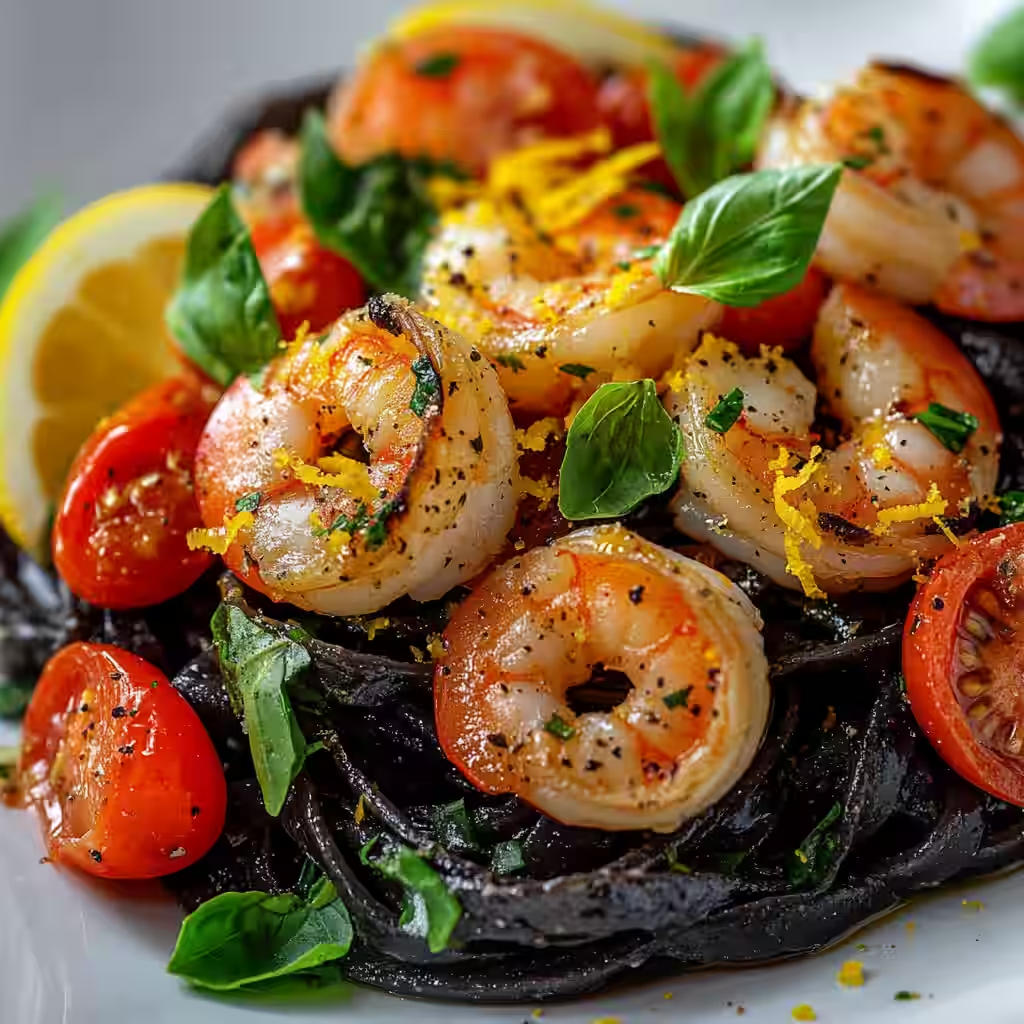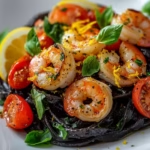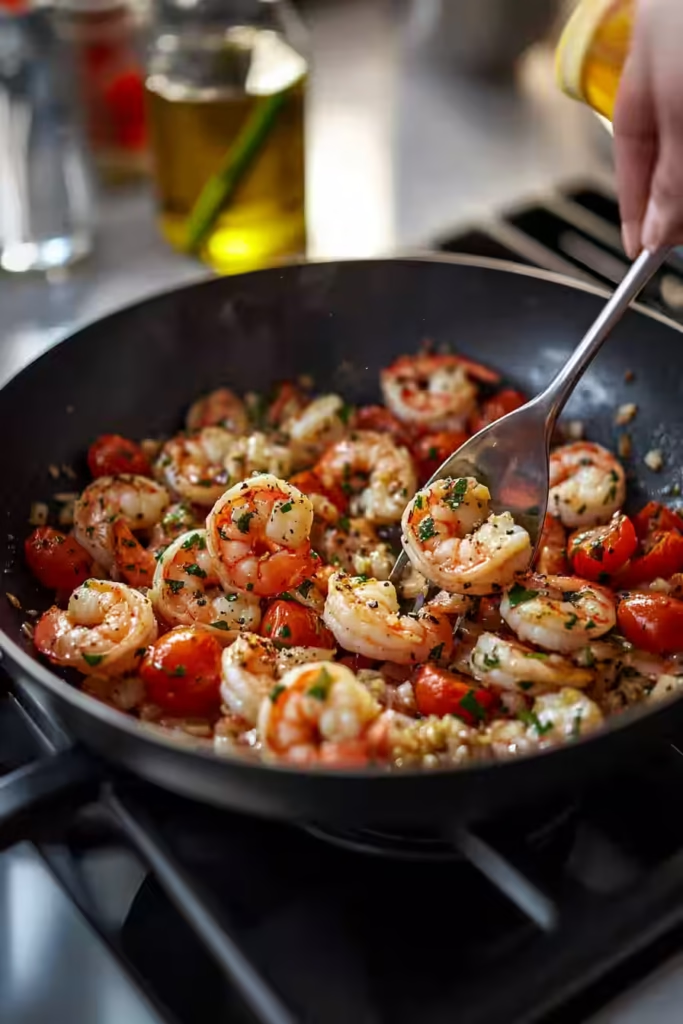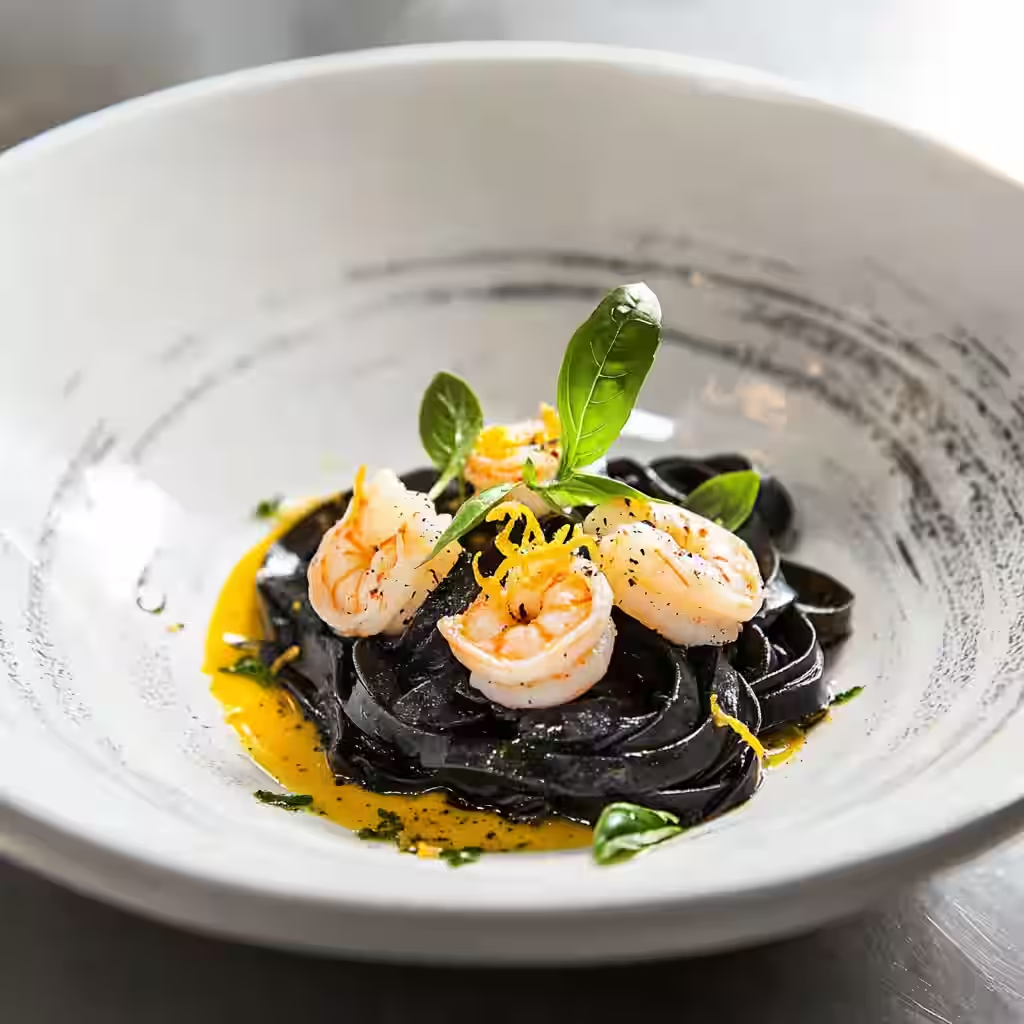Squid ink pasta isn’t just food, it’s an experience. At Cookmoo, we believe food should tell a story, and this dish is pure poetry on a plate. It’s dramatic, savory, elegant, and unexpectedly simple to prepare. Inspired by memories of family kitchens, quiet picnics, and the magic of food that connects generations, this recipe is a bold leap into the rich, briny depths of Mediterranean flavor, with a Southern heart. Today, I’ll walk you through how to make squid ink pasta with shrimp that delivers visual wow-factor and gourmet taste without the fuss.
Table of Contents
Introduction to Squid Ink Pasta
What is Squid Ink Pasta?
Black pasta, famously made by blending squid or cuttlefish ink into the dough, delivers a dramatic color and a signature umami punch that takes your plate from simple to stunning. More than just a visual standout, the ink brings in deep, briny notes that pair beautifully with seafood and citrus. While it can be homemade, we’re using top-quality store-bought squid ink pasta for ease and flavor consistency.
Rooted in coastal Italian and Spanish cuisine, this rich pasta style has been cherished for generations. Its bold color and ocean-inspired flavor create the perfect canvas for buttery shrimp, juicy tomatoes, garlic, and lemon.
The Rise in Popularity of Squid Ink Dishes
From fine dining menus to trending online food reels, ink-infused noodles are having a moment. And it’s no surprise, they’re dramatic, flavorful, and surprisingly easy to prepare. More home cooks are reaching for gourmet touches that don’t require professional skills, and briny seafood pasta delivers just that. Whether you’re hosting a dinner party or elevating your weeknight meal, this dish is sure to impress ; similar to our Marry Me Chicken Pasta, another rich and satisfying recipe that brings restaurant-style flavor home.
What Makes Squid Ink Pasta Special?
Unique Appearance and Visual Appeal
First things first, black noodles just look cool. Whether served in a rustic bowl or plated fine-dining style, squid ink pasta instantly turns heads. The inky black strands create contrast with colorful ingredients like vibrant cherry tomatoes, fresh green basil, and perfectly cooked pink shrimp. This contrast doesn’t just catch the eye, it elevates the entire dining experience.
If you’ve ever wanted to serve a dish that feels restaurant-worthy but still homemade, this is it. It’s one of those meals where people pause before eating just to admire it—and then go in for seconds.
Complex Umami-Rich Flavor Profile
What truly sets this pasta apart isn’t just its color, it’s the depth of flavor. The ink imparts a gentle brininess and natural umami, adding a savory oceanic kick without being overpowering. When paired with sweet tomatoes, sharp lemon, and garlic-infused olive oil, the flavors balance out beautifully.
This dish brings together the richness of the sea with the brightness of citrus and herbs. The result? A gourmet-level bite that lingers, in a good way. It’s the kind of flavor that keeps you going back for another forkful.
Nutritional Breakdown and Health Considerations
Is Squid Ink Pasta Unhealthy? Let’s Find Out
Let’s clear the air, just because squid ink pasta looks indulgent doesn’t mean it’s unhealthy. In fact, it can be quite balanced when paired with clean, whole ingredients. The ink itself is low in calories and rich in antioxidants, which may offer anti-inflammatory benefits. It also contains trace minerals like iron and selenium, giving it more nutritional value than standard pasta.
Of course, the pasta dough (like all wheat-based varieties) does contain carbs, but that’s not a bad thing when eaten in moderation. What matters more is what you serve with it, and this recipe brings in lean protein from shrimp, healthy fats from olive oil, and fresh vegetables.
Health Benefits of Squid Ink and Seafood Ingredients
Shrimp, the star protein here, is not only low in calories but also packed with omega-3 fatty acids, which support heart and brain health. Plus, it’s rich in vitamin B12, iodine, and high-quality protein.
Pair that with garlic (known for its immune-boosting properties), fresh tomatoes (full of lycopene), and lemon juice (a natural source of vitamin C), and you’ve got a dish that tastes indulgent but feels nourishing.
This meal isn’t just about flavor, it’s about balance. You’re getting protein, fiber, and essential nutrients all in one dish ; just like many of the wholesome ideas in our collection of recipes with ditalini pasta.
PrintSquid Ink Pasta with Shrimp & Cherry Tomatoes
A bold and flavorful dish, this squid ink pasta with shrimp blends briny seafood, lemon, garlic, and herbs into a stunning 30-minute gourmet meal. Perfect for special dinners or easy weeknights, it’s rich, vibrant, and surprisingly simple to prepare.
- Prep Time: 10 min
- Cook Time: 20 min
- Total Time: 30 min
- Yield: 4 1x
- Category: Pasta
- Method: Stovetop
- Cuisine: Italian
Ingredients
- 12 ounces squid ink pasta
- 1 pound shrimp (peeled and deveined)
- 1 Tablespoon extra virgin olive oil
- 6 cloves garlic (thinly sliced)
- 2 Tablespoons tomato paste
- 10 ounces cherry tomatoes (halved)
- 1/4 cup vegetable or seafood broth + 1 tablespoon lemon juice
- ½ teaspoon red pepper flakes
- 2 lemons (zested and juiced)
- 1/2 cup chopped basil
- 4 Tablespoons butter
- Kosher salt
- Freshly ground black pepper
Instructions
- Boil Pasta: Bring a large pot of salted water to a boil. Cook the pasta until al dente. Reserve ½ cup of pasta cooking water before draining.
- Sauté Garlic & Tomato Base: In a large skillet, heat olive oil over medium-high heat. Add garlic and sauté for 1–2 minutes until lightly browned and fragrant. Stir in the tomato paste and cook for 30 seconds to 1 minute until dark red.
- Simmer Tomatoes: Add cherry tomatoes, broth + lemon juice mixture, ¼ cup water, and red pepper flakes. Season with salt and pepper. Cook 3–5 minutes, stirring occasionally, until tomatoes are softened.
- Cook Shrimp: Add shrimp to the skillet and season with salt and pepper. Cook 2–3 minutes, stirring occasionally, until the shrimp are opaque and cooked through.
- Combine and Finish: Add the cooked pasta, butter, lemon zest, lemon juice, and half the reserved pasta water to the skillet. Toss everything together for 2–3 minutes until the pasta is coated. Add more pasta water if needed to loosen the sauce. Turn off the heat and stir in half the basil.
- Serve: Garnish with the remaining basil and serve immediately.
Notes
- Best enjoyed fresh, but leftovers can be stored in an airtight container in the fridge for up to 2 days.
- Reheat gently on the stove or in the microwave.
Nutrition
- Serving Size: approx. 1 ¾ to 2 cups
- Calories: 505kcal
- Sugar: 6.5g
- Sodium: 1085mg
- Fat: 15g
- Saturated Fat: 7g
- Carbohydrates: 71g
- Fiber: 4g
- Protein: 35g
- Cholesterol: 315mg
Keywords: Squid ink pasta, shrimp, without wine, cherry tomatoes, tomato
Core Ingredients for the Perfect Dish
Why These Ingredients Work Together
This recipe isn’t just delicious, it’s thoughtfully constructed. Every ingredient complements the bold flavor of squid ink pasta, creating a perfectly layered bite.
- Shrimp brings sweetness and briny richness that highlights the subtle oceanic notes of the pasta.
- Garlic and tomato paste add depth and warmth, forming a rich base without overpowering the delicate seafood flavors.
- Cherry tomatoes burst with juiciness and acidity, helping balance the richness of butter and oil.
- Lemon zest and juice cut through with brightness and lift, making the whole dish feel light and refreshing.
- Basil delivers an herbal contrast that ties everything together beautifully.
Together, these ingredients transform what could be an intimidating dish into a warm, comforting meal packed with flavor.
Substitutions and Optional Enhancements
Want to tailor the dish to your preferences or pantry?
Here are a few easy swaps:
- Pasta: If you can’t find black pasta, use regular spaghetti and add a splash of bottled squid ink to the sauce.
- Shrimp: Sub with scallops, calamari, or even grilled chicken for a different spin.
- Butter: Use plant-based butter or a drizzle of cream if you’re leaning toward a richer finish.
- Herbs: Basil is classic, but parsley or chives work well too.
Want to bulk up the meal? Try tossing in baby spinach or arugula at the end for a nutrient boost.
Step-by-Step Guide to Cooking Squid Ink Pasta with Shrimp
This squid ink pasta with shrimp may look fancy, but it’s surprisingly easy to master. You can pull off this restaurant-quality dish in under 30 minutes, no advanced techniques required. Let’s walk through the steps to bring this jet-black, flavor-packed dish to life.
Full Recipe Instructions Explained
1. Boil the Pasta
Start by boiling a large pot of salted water. Add the squid ink pasta and cook until just al dente. Don’t forget to reserve about ½ cup of the starchy pasta water before draining, it’s essential for creating a silky, cohesive sauce.
2. Sauté the Garlic & Tomato Base
In a wide skillet, let the olive oil heat up until it shimmers over medium-high heat. Add the sliced garlic and cook for about 60 seconds until fragrant. Stir in the tomato paste and cook until it turns deep red, this adds intensity to your squid ink pasta sauce.
3. Simmer the Tomatoes
Next, add halved cherry tomatoes, the lemon juice-broth mix, ¼ cup water, and red pepper flakes. Season well with salt and pepper. Let everything simmer for 3–5 minutes. This forms the juicy, acidic base that contrasts beautifully with the deep flavor of the pasta.
4. Cook the Shrimp
Toss the shrimp into the skillet. Season again with a touch of salt and pepper. Cook until pink and opaque, about 2–3 minutes. The shrimp’s sweet, buttery flavor balances the brininess of the squid ink pasta perfectly.
5. Combine and Finish the Dish
Now, add the drained pasta to the pan along with butter, lemon zest, lemon juice, and half of the reserved cooking water. Toss to combine. Stir in half the chopped basil. The sauce should cling to each strand of squid ink pasta, coating it with bold, balanced flavor. Add more water if the sauce feels too thick.
6. Garnish and Serve
Plate the pasta while it’s hot. Top with the remaining basil and an extra twist of lemon if desired. The visual contrast of the black noodles, bright green herbs, and pink shrimp makes this squid ink pasta with shrimp a true showstopper.
Master your pasta game by learning the difference between firm and soft textures with our guide on how long to cook ditalini pasta, a must for pasta perfectionists
Tips for Perfect Pasta Texture and Balanced Flavor
- Always salt your pasta water, especially for bold dishes like squid ink pasta.
- Never rinse the pasta. The surface starch helps the sauce bind.
- Add lemon juice gradually and taste for balance. It should brighten, not overwhelm.
- For added luxury, swirl in a splash of cream just before serving.
Flavor Secrets: Enhancing Squid Ink Pasta
Garlic, Lemon, and Tomato Magic
The soul of this squid ink pasta dish lies in its flavor layers. Let’s start with the base ; garlic. Thinly sliced and lightly browned in olive oil, it brings a mellow, nutty warmth that permeates the sauce. It’s not just an aromatic, it’s the backbone of the dish.
Next comes tomato paste, a powerful ingredient that adds depth and a slight sweetness. Cooking it until dark red intensifies its umami notes, which pairs beautifully with the natural saltiness of the pasta and shrimp.
And then there’s lemon-zest and juice. These do double duty: the zest adds a bright aromatic lift, while the juice balances the brininess of the black pasta with crisp acidity. Together, these three elements create a rich, balanced foundation.
The Role of Basil and Butter in Building Flavor
Fresh basil, added in two stages, adds brightness and a hint of sweetness. Stirring it in at the end keeps it vibrant and fresh, while garnishing with extra basil right before serving creates a layered herbal finish that cuts through the richness.
Butter plays its quiet but crucial role here too. It helps emulsify the sauce, giving your squid ink pasta with shrimp that silky, restaurant-style coating that clings to every strand. This finishing touch marries the bold seafood and citrus elements into one unified flavor profile.
To take things even further, you can add a pinch of smoked paprika or Calabrian chili paste if you like heat—or even a splash of white wine before the tomatoes go in, for added complexity.
Serving Suggestions and Pairings for Squid Ink Pasta
Best Side Dishes to Complement Squid Ink Pasta with Shrimp
When serving squid ink pasta with shrimp, simplicity is your best friend. The dish already brings a bold, briny punch, so side items should provide balance without stealing the spotlight.
Here are some no-fuss, flavor-boosting sides to serve with it:
- Crispy garlic bread or focaccia – Toasted to golden brown and perfect for scooping up any leftover sauce.
- Lemon-dressed arugula or spinach salad – Offers a peppery bite and bright citrus zing that cuts through the rich seafood.
- Roasted vegetables – Think lightly seasoned zucchini, asparagus, or bell peppers to bring sweetness and crunch.
- Simple steamed green beans or snap peas – Fresh and clean, they balance the boldness of the black pasta perfectly.
Plating and Presentation Tips
Part of the appeal of squid ink pasta is its dramatic appearance. With its deep black strands and golden shrimp, this dish practically plates itself like fine art. Here’s how to make your presentation pop:
- Twirl the pasta into small nests on each plate using tongs or a carving fork. It creates visual height and structure.
- Top with whole basil leaves, a light drizzle of olive oil, and a bit of lemon zest for fresh color and citrus fragrance.
- Use white or ceramic plates; the contrast against the black noodles enhances the overall look.
- Finish with a sprinkle of flaky sea salt or fresh-cracked pepper just before serving for that final flavor lift.
This isn’t just dinner, it’s an experience. Whether you’re hosting guests or treating yourself to something special, this dish offers both elegance and comfort.
Storage, Reheating & Final Thoughts
How to Store and Reheat Leftovers
While squid ink pasta with shrimp is best enjoyed fresh, you can absolutely save leftovers for later. Here’s how to do it right without sacrificing texture or flavor:
Storage Tips
- Allow the pasta to cool slightly before transferring it to an airtight container.
- Store in the refrigerator for up to 2 days.
- Keep the shrimp and pasta together to maintain flavor cohesion, but stir gently before reheating.
Reheating Tips
- Reheat gently in a skillet over medium-low heat with a splash of water or broth to loosen the sauce.
- Avoid microwaving for too long, short bursts work better to keep the shrimp tender and the noodles from drying out.
- For best results, cover the pan while reheating to retain moisture.
Pro Tip: If the sauce has thickened in the fridge, stir in a little lemon juice and butter while reheating to revive its glossy finish and fresh citrus flavor.
Final Cooking Tips for First-Time Cooks
If it’s your first time making squid ink pasta, here are a few reminders to guarantee success:
- Don’t overcook the shrimp: they should be just opaque and tender.
- Taste your sauce before serving; adjust lemon or salt to balance the boldness of the ink.
- Use fresh herbs to brighten the entire dish: basil or parsley work beautifully.
- Plate with care: This dish is visually stunning, so make it pop with color and texture.
Whether you’re serving this for a special dinner or just feeling fancy on a Wednesday night, squid ink pasta with shrimp brings elegance and bold flavor to your table with surprisingly little effort.
For more recipes follow me in Pinterest.
Frequently Asked Questions About Squid Ink Pasta
What is so special about squid ink pasta?
What makes squid ink pasta stand out isn’t just its striking black color, it’s the flavor. The ink adds a mild brininess and deep umami that transforms an ordinary pasta dish into something sophisticated and memorable. It’s a taste that hints at the sea without being overwhelmingly fishy. Combined with vibrant ingredients like shrimp, garlic, and lemon, the flavor of squid ink pasta truly shines. It’s special because it’s both visually dramatic and incredibly balanced in taste.
What does squid ink taste like?
Squid ink has a naturally salty, oceanic flavor, often described as savory, earthy, and rich in umami. It’s not overly fishy, instead, it adds subtle depth to dishes, much like anchovy paste or miso might do. In pasta, the ink binds beautifully with acidic and buttery ingredients like tomato and lemon, giving your dish a complex, layered flavor.
Is squid ink pasta unhealthy?
Not at all. In moderation, squid ink pasta can be part of a well-rounded, nutrient-rich meal. The ink itself contains antioxidants, iron, and other minerals, while the pasta provides energy-boosting carbs. When paired with lean proteins like shrimp, fresh herbs, and veggies, it becomes a wholesome and balanced dish. Like with any pasta, portion control is key, but there’s nothing inherently unhealthy about enjoying this beautiful seafood pasta.
What to use squid ink pasta for?
While it pairs best with seafood, squid ink pasta is more versatile than you might think. Use it as a base for:
– Shrimp, scallops, or calamari-based sauces
– Garlic butter sauces with fresh herbs
– Light tomato sauces with basil and citrus
– Vegetable-forward dishes using mushrooms, roasted tomatoes, or spinach
Its bold appearance makes it ideal for dinner parties or special occasions when you want to serve something visually impressive and full of flavor.
What does squid ink do to pasta?
Squid ink gives pasta its iconic jet-black color and a unique flavor boost. It infuses the dough with a briny, oceanic taste that’s rich in umami and slightly salty, adding depth that traditional pasta lacks. When cooked, squid ink pasta absorbs these savory notes, making it a perfect partner for seafood and citrus-based sauces.
What is squid ink made of?
Squid ink is a natural dark liquid secreted by squid (or cuttlefish) as a defense mechanism. It’s primarily composed of melanin, enzymes, and amino acids. In cooking, it’s prized for its deep color and briny umami taste. Food-grade squid ink is cleaned and purified before being sold in jars or sachets for culinary use.
Do Italians eat squid ink pasta?
Yes, squid ink pasta has deep roots in Italian coastal cuisine, especially in regions like Sicily and Venice. It’s commonly served with fresh seafood, olive oil, garlic, and lemon. Italians often use it to showcase fresh, local ingredients, and it’s considered both a delicacy and a traditional dish passed through generations.
What kind of sauce goes with squid ink pasta?
The best sauces for squid ink pasta are those that highlight and complement its bold flavor without overpowering it. Think:
– Garlic butter sauce with shrimp or scallops
– Tomato-based sauces with a splash of lemon
– Citrus-herb olive oil sauces
Avoid overly creamy or heavy sauces ; they can dull the natural brininess of the pasta. Lighter, oil-based or tomato-forward sauces help the ink’s subtle taste stand out.





